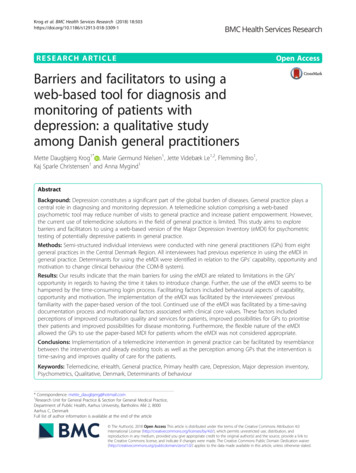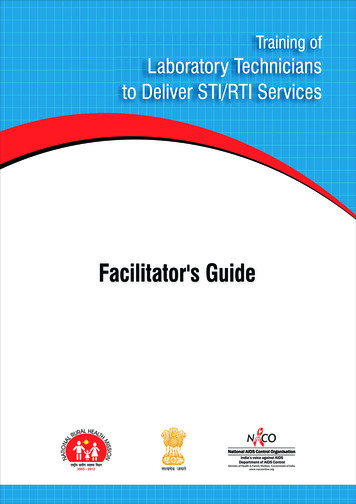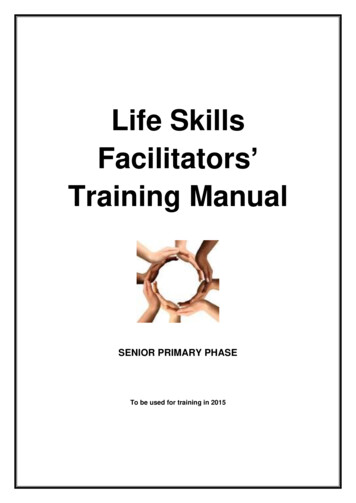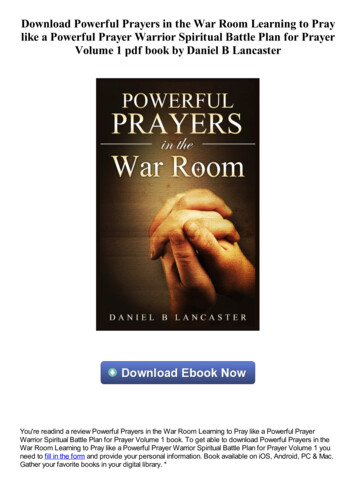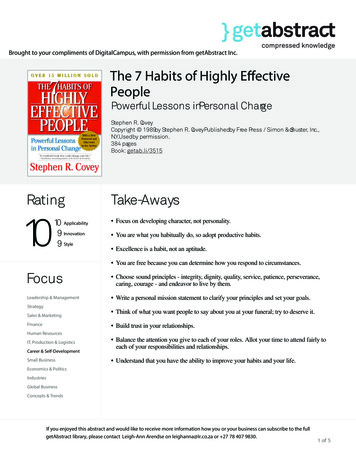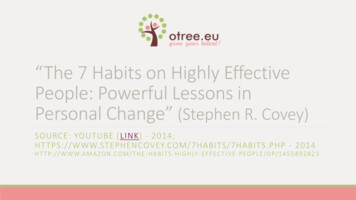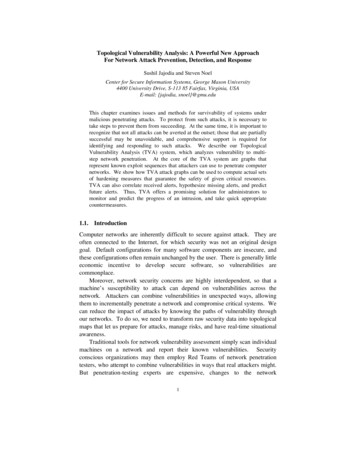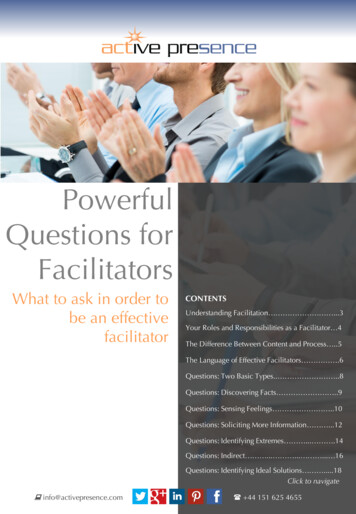
Transcription
PowerfulQuestions forFacilitatorsWhat to ask in order tobe an effectivefacilitatorCONTENTSUnderstanding Facilitation .3Your Roles and Responsibilities as a Facilitator 4The Difference Between Content and Process .5The Language of Effective Facilitators .6Questions: Two Basic Types. .8Questions: Discovering Facts .9Questions: Sensing Feelings .10Questions: Soliciting More Information .12Questions: Identifying Extremes . .14Questions: Indirect . . . 16Questions: Identifying Ideal Solutions .18Click to navigate info@activepresence.com 44 151 625 4655
Created by:Active Presence LimitedWirralCH48 3JJUK 44 151 625 4655 info@activepresence.comRegistered in England, company number: 4588126VAT No: GB 854 2129 33Copyright 2013 Active Presence LimitedReference is made to Successful Speaking Secrets Quick ReferenceWritten by Chris DavidsonPublished in 2010ISBN 9780955604126Available from Active Presence LimitedDistribution date of this version: August 2013All rights reserved. No part of this publication may be transmitted in any form or by any meanselectronic or mechanical, including photocopying, recording, or any storage and retrievalsystem, without prior permission in writing from the publisher
Understanding FacilitationIn many organisations across the business spectrum, people are discovering the benefits ofusing a neutral third party to oversee and improve meetings. In the business world, the hybridand vital role of facilitator has emerged.What does a facilitator do?A facilitator:A facilitator does not:manages the meetingtake part in the discussiongives participants the relevant structure and toolstry to influence the outcomemakes sure everyone is heardoffer their own viewhelps participants identify their goalsmake decisionshelps participants to develop their action planstake control of the contentprovides leadershiphelps others assume responsibility and take chargethemselvesExamples of where facilitation skills can be useful:a strategic planning sessiona session to clarify objectives and create detailed results indicatorsa priority-setting meetinga team-building sessiona program review/evaluation sessiona communication/liaison meetinga meeting to negotiate team roles and responsibilitiesa problem-solving meetinga meeting to share feedback and improve performancea focus group to gather input on a new program or product Active Presence, 20133
Your Roles and Responsibilities as a FacilitatorAs a facilitator you can make a huge and varied contribution to an organisation:You can help group members define their overall aim, as well as specific objectivesand goalsYou can instruct members on how to assess needs – and create plans to fulfil themYou will possess the correct knowledge of processes and skills needed to helpparticipants become time effective and make high-quality decisionsYou can provide feedback to the group, so that they can measure their progress andmake adjustments where neededYou will emphasise the importance of communicating effectively, and ensure membersknow how to do thisYour aim will be to create a positive environment where employees can workproductively and reach shared group goalsYou will aim to manage conflict by implementing a collaborative approachYou can pass on your skills through teaching and empowering, so that members of thegroup will have a good idea of the art of facilitationYou can offer support and advice to members in managing their own personaldynamicsYou will help participants assess the skills they already possess and advise them on how toacquire new ones. Active Presence, 20134
The Difference Between Content and ProcessTo be a successful facilitator, you need to be clear a about the difference between content andprocess.Content means the subjects being discussed, and the tasks at hand. Content isexpressed through the agenda and consumes most of the attention of the participants.Process is the way in which the content is discussed; this should include things such asthe style of interaction, the group dynamics and the climate that has been established.It is your job as the facilitator to manage the process and leave the content to theparticipants.ContentProcessWhat?How?The subjects for discussionThe methods and proceduresThe taskHow relations are maintainedThe problems being solvedThe tools being usedThe decisions madeThe rules or norms setThe agenda termsThe group dynamicsThe goalsThe climate Active Presence, 20135
The Language of Effective FacilitatorsWhen you act as a facilitator, you need to remain a neutral force for the whole time you are incontrol. There are four main language techniques that can help you focus on process and notinfluence content: ParaphrasingFeeling identificationInsight clarificationObservations of participant’s conductThe most important thing is that you must not sound judgemental or critical.ParaphrasingInvolves describing, in your own words, what another person’s remarks convey:“Do I understand you correctly that ”“Are you saying ?”“What I’m hearing you say is ”You need to be paraphrasing continuously throughout. It is a very useful way of dealingwith potential conflicts and clarifying peoples’ opinions. You will put members at ease byparaphrasing, simply because it shows their opinions are being heard and acknowledged.Identifying feelingsThis generally consists of specifying and identifying a feeling either by naming, using ametaphor or using a figure of speech.“I feel we’ve run out of energy” (Naming)“I feel as if we’re facing a brick wall” (Metaphor)“I feel like a fly on the wall” (Figure of speech)As a facilitator, you need to be in tune with how you’re feeling and be more thanwilling to share those feelings with the group. Honesty is definitely the best policy. Revealingyour feelings encourages others to share their own.Clarifying insightThis is describing what you perceive to be another person’s inner state, to check if youunderstand what he or she is feeling.“You appear upset by the last comment that was made. Are you?”“You seem impatient. Are you anxious to move on to the next topic?” Active Presence, 20136
Insight clarification lets you take the pulse of participants who may be experiencingemotions that get in the way of their participation. It also encourages a participant to share anopinion that they, initially, were not going to voice within the discussion group.Observer conductThis involves relating back to the participants what you have been able to observeabout their behaviours, without making accusations or generalisations about them as people,or attributing motives to them,“I’m noticing that we’ve only heard from this group of people throughout most of thisdiscussion”“I’m noticing that several people are working on their emails”By describing specific behaviours, you give participants information about how theiractions are being perceived. Feeding this information back to the participants in a nonthreatening manner opens the door for individuals to suggest actions to improve the existingsituation. Active Presence, 20137
Questions: Two Basic TypesOpen questionsAn open question requires more than a yes or no answer, often stimulates thinking andusually begins with the words ‘What’, ‘How’, ‘When’ or ‘Why?’Example:“What conclusion has the group come to, to decide whether today’s meeting was asuccessful endeavour?”Closed questionsA closed question requires a one-word answer, closes off discussion and usually beginswith the words, ‘Is’, ‘Can’, ‘How many’, ‘Does?’Example:“Is everyone happy to proceed to the next topic?” Active Presence, 20138
Questions: Discovering FactsThis type of questioning helps you to assess the current situation of the organisation or itsemployees. These can often be closed questions which only require a one-word answer, ashow of hands, or a short response from the participants. Verifiable data: Who? What? When?Where? How much?Example questions:“What kind of computer equipment are you now using?”“What position in the company do you hold?”“How much training did your staff receive at the start?”“How many staff will be attending this meeting?”“How many topics do we have to be discussed at this meeting?”“Who is willing to be the spokesperson in your group?”“Who here has been informed of the topics that are up for discussion today?”“Where did the staff complete their training?”“From where did the organisation originate?”“Who does not fully understand the last point that was discussed?”“How much of the last point discussed do you agree with?”“Are you fully aware of the issues we need to discuss?”“Where would you like to see the debate go next?”“Would you attend another meeting like this?”“Have you been involved in a meeting with the same concept as this one before?”“How long have you been at the organisation?”“Do you intend to stay at this organisation for the foreseeable future?”“How much have you been told about the meeting here today?”“Is there anybody here who knows the concept of facilitation?”“Have we reached a conclusion everyone is happy with?”“Is this an appropriate time slot for everyone?”“Has everyone felt they have learned something today?” Active Presence, 20139
Questions: Sensing FeelingsThese questions are designed to unlock subjective information that gets at the participant’sthoughts, values, opinions, feelings and beliefs. They are useful in allowing you to understandindividual and collective views.Sensing feelings questions usually contain words such as ‘think’ or ‘feel’.Example questions:“How do you feel about the effectiveness of the new equipment?”“Do you think that the staff felt they received enough training?”“How did you feel about the points that were raised earlier in the meeting?”“Do you think that after the meeting we will have reached a suitable agreement for allparties?”“How do you feel about the new interview procedure that has been implemented?”“Do you think that the marketing department has produced a product that meets theclient’s expectations?”“How would you feel if you were put in the same situation?”“Do you think that employees are listened to enough by the management?”“How do you feel about the manner in which the task was completed?”“Do you think that the method chosen to deal with this particular issue was the rightchoice?”“Did you expect that enough time would be put aside to ensure the task wascompleted?”“Did you expect to feel differently about the agreement made as a result of the meetingtoday?”“Do you feel you were holding back and could have contributed more to thediscussion?”“Which topic we discussed do you feel was the most relevant?”“Do you think that decision would benefit the organisation in the long run?”“How do you feel you would have reacted if you were in the same situation?”“Do you think the manager behaved in an appropriate manner?”“Do you think the client would be happy with this sort of approach?” Active Presence, 201310
“Do you expect the meeting today will be able to resolve some difficulties?”“Do you think that the fault lies at the marketing department’s door?”“Did you feel there was enough communication between the staff involved in thisparticular task?”“Do you feel that you performed your duties to the best of your ability on this task?”“Who do you feel should have taken responsibility in that situation?”“Do you feel you and your team were adequately prepared for dealing with thissituation?”“Do you feel there are any changes you could have made?”“Do you feel you will be able to provide an impartial view on this subject?”“How would you have felt as a customer, receiving the same sort of service?” Active Presence, 201311
Questions: Soliciting More InformationThese questions can help you extract more information from the speaker. They allow thespeaker to elaborate and explain in more detail points you have acknowledged as of particularimportance. A good facilitator will know when the participant’s answer did not have enoughfocus, and so know when to solicit more from them.You can also ask if anybody else feels they can expand on what the participant has justsaid, so keeping a nice flow to the meeting and also encouraging more participant involvementand interaction.Example questions:“Can you be more specific?”“Can you expand on that point?”“Tell me more”“Can you elaborate more on that point?”“Do you have anything else to add?”“Could you go on?”“Were you holding back on anything?”“Could you focus upon your first point more?”“Is that the only information you have?”“Were you informed of anything else worthy of note?”“Is that as much as you know on that subject?”“Would you care to share more on this subject?”“Are you willing to share anymore?”“Is that as far as your knowledge goes?”“If you were pushed for an answer, what would you say?”“Can you improve on the points you just made?”“Can anybody else add anything to this?”“Does anyone else think they can add to this?”“Does anyone else share these views and feel they can contribute?”“Anything else you can think of which is particularly memorable or remarkable?” Active Presence, 201312
“Is that everything you intended to say?”“Have you expressed all the views you have on that subject?”“Have you said all you can on that issue?”“Let’s take what you said and expand some more, shall we?”“Could you explain in a little more detail?”“You told me you were struggling to offer a definitive answer before, have you reacheda conclusion now?”“Could I press you on that issue a little bit more, if you wouldn’t mind?”13
Questions: Identifying ExtremesThese questions help you understand the potential opportunities in the meeting. They allowyou, as the facilitator, to test the outer limits of participants’ wants and needs. You can gainperspective on what participants identify as being positives or negatives and advantages ordisadvantages with relevance to particular aspects of the current situation.Example question
These questions can help you extract more information from the speaker. They allow the They allow the speaker to elaborate and explain in more detail points you have acknowledged as of particular
